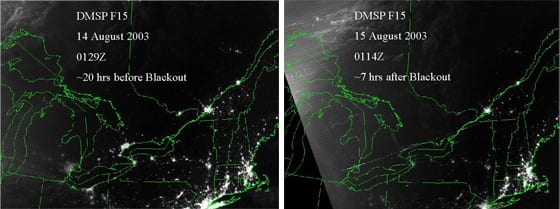Ten years after the 2003 Northeast Blackout, much has changed
August 14, 2013, marks the ten-year anniversary of one of the most notable dates in the history of power system operations: the 2003 Northeast Blackout. On this day, more than 50 million people in the US and Canada lost power—and it all happened in a matter of seconds. It is still considered the most widespread outage in our nation’s history. Though only small areas of New England were affected, the blackout prompted a thorough review of the standards and procedures for operating the nation’s power system, and resulted in changes that affect how all grid operators, including ISO New England, manage the system today.
What happened?
On the afternoon of August 14, 2003, conditions on the power system in the northeastern part of Ohio began deteriorating after a series of transmission line and generator outages occurred. By 4:10 p.m., what began as separate, independent events ultimately evolved into cascading outages that affected vast areas of New York, Ontario, and the Midwest, in just seven seconds.
New England was largely spared from the effects of the outage because protective equipment installed on the transmission system sensed the disturbance and automatically closed the ‘electricity border’ with New York, splitting New England away from the collapsing power system to the west.
While New England was disconnected from the rest of the Eastern Interconnection for nearly ten hours, ISO New England system operators were able to work closely with New England’s generators to keep the power system in balance. Some scattered outages in New England occurred, mainly in southwestern Connecticut and small portions of western Massachusetts and Vermont. These areas were affected because they are directly connected to the New York power grid, where the blackout had serious impacts. ISO system operators worked with local utilities to restore power to all the affected areas in New England within 12 hours of the initial disruption. In other areas most impacted by the blackout, such as New York, it took up to two days to restore power.

What’s changed?
Mandatory reliability standards
In response to the blackout, Congress included provisions in the Energy Policy Act of 2005 that authorized the Federal Energy Regulatory Commission (FERC) to designate a national Electric Reliability Organization (ERO) and required the development of mandatory reliability standards that govern the planning and operation of the power system. Under FERC’s direction, the North American Electric Reliability Corporation (NERC) became the nation’s ERO, charged with ensuring the reliability of the bulk power system in North America. Since then, NERC has implemented more than 100 mandatory and enforceable reliability standards, ranging from vegetation management practices, to emergency preparedness, to system operator training and certification. ISO New England system operators each hold mandatory licenses and receive approximately 130 hours of training in the classroom and with power system simulators every year.
Regional Transmission Organizations
One of ISO New England’s recommendations following the blackout was the formation of Regional Transmission Organizations, or RTOs, with clear operational authority over regional transmission systems. In 2005, ISO New England became the Regional Transmission Organization for the six-state region, giving the ISO broader authority over the day-to-day operation of the transmission system and ensuring a “single set of hands on the wheel” to manage grid reliability.
Transmission investment
Since 2000, ISO New England and New England stakeholders have worked diligently to ensure a reliable grid through an annual system planning process that looks 10 years into the future to identify limitations on the regional power system. Since this process began, the reliability of the region’s transmission system has been greatly improved, with more than $5.3 billion invested in over 400 transmission projects. Another $5.7 billion in infrastructure upgrades to address reliability needs is planned for the next seven years.
Smarter equipment
Among the US Department of Energy (DOE) recommendations following the blackout was installation of equipment such as synchrophasors that can give system operators both a wider and more granular view of system conditions. ISO New England received a grant from the DOE in 2009 and, working with transmission owners, has installed 35 synchrophasors across the high-voltage power system. Currently, data from the synchrophasors are streaming to the transmission owners’ and ISO New England’s data concentrators—at 30 times per second! The ISO and transmission owners are now entering an observation phase where advanced applications will be explored, which will help determine the steps necessary for potential integration of this data into power system operation.
Could it happen again?
The blackout put a spotlight on the fact that the nation’s power grid is highly interconnected: what happens in one region can quickly affect operations in other regions. According to Vamsi Chadalavada, executive vice president and chief operating officer of ISO New England, the industry is doing more than ever before to ensure grid reliability.
“Over the past 10 years, great strides have been made in the industry to improve how we plan and operate the grid, to enhance coordination and communication between regions, and to strengthen the transmission system. At the same time, new threats are emerging such as cyber security,” Chadalavada said. “The power system is an incredibly complex machine and given a system of this complexity, the probability of a blackout, while low, does exist. Although we can’t predict every type of incident that could occur, we plan for contingencies and our system operators are trained on how to react in emergency situations. The bottom line is, if problems arise, we are prepared to address them.”
To learn more about the 2003 blackout, read the Final Report on the August 14, 2003 Blackout in the United States and Canada: Causes and Recommendations, developed by the US-Canada Power System Outage Task Force.
- Categories
- Inside ISO New England
- Tags
- new england states, system operations, transmission planning
